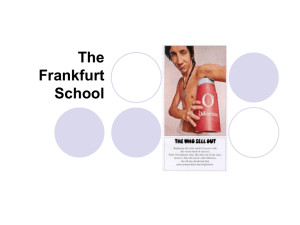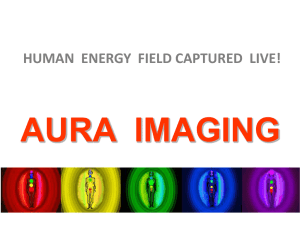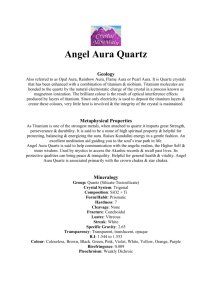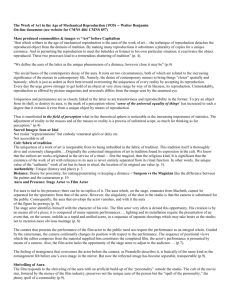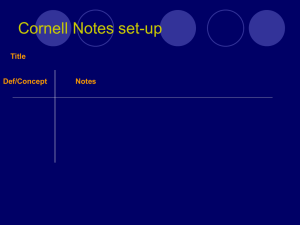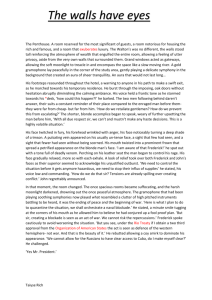Boris Groys ::: Biography ART IN THE AGE OF BIOPOLITICS From
advertisement
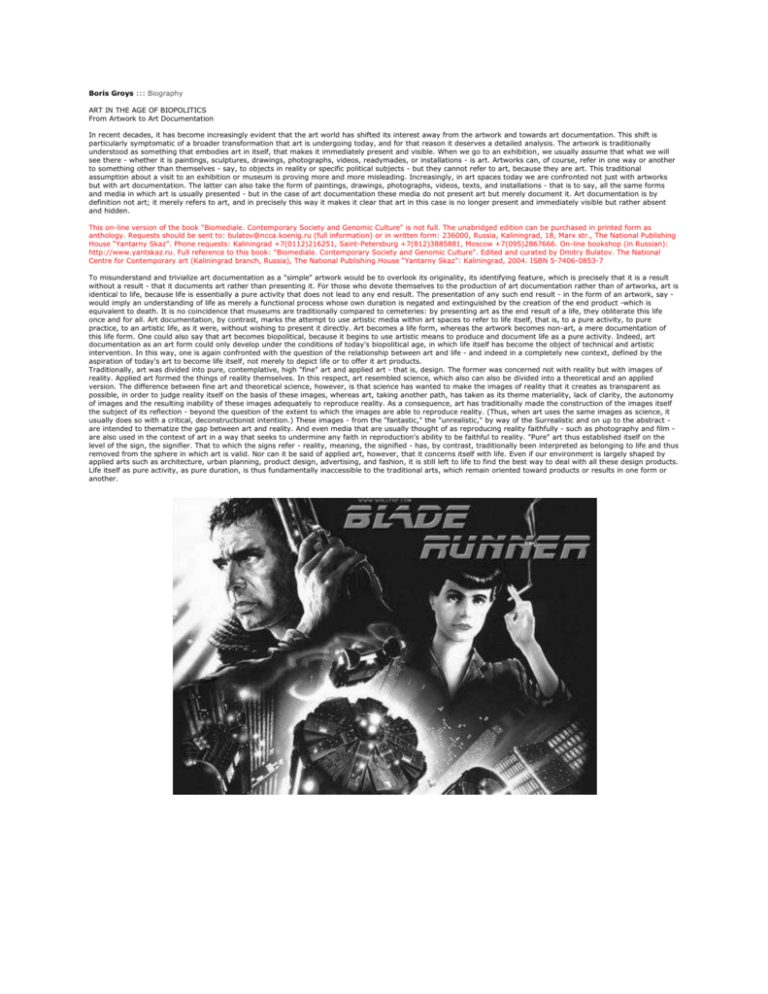
Boris Groys ::: Biography ART IN THE AGE OF BIOPOLITICS From Artwork to Art Documentation In recent decades, it has become increasingly evident that the art world has shifted its interest away from the artwork and towards art documentation. This shift is particularly symptomatic of a broader transformation that art is undergoing today, and for that reason it deserves a detailed analysis. The artwork is traditionally understood as something that embodies art in itself, that makes it immediately present and visible. When we go to an exhibition, we usually assume that what we will see there - whether it is paintings, sculptures, drawings, photographs, videos, readymades, or installations - is art. Artworks can, of course, refer in one way or another to something other than themselves - say, to objects in reality or specific political subjects - but they cannot refer to art, because they are art. This traditional assumption about a visit to an exhibition or museum is proving more and more misleading. Increasingly, in art spaces today we are confronted not just with artworks but with art documentation. The latter can also take the form of paintings, drawings, photographs, videos, texts, and installations - that is to say, all the same forms and media in which art is usually presented - but in the case of art documentation these media do not present art but merely document it. Art documentation is by definition not art; it merely refers to art, and in precisely this way it makes it clear that art in this case is no longer present and immediately visible but rather absent and hidden. This on-line version of the book "Biomediale. Contemporary Society and Genomic Culture" is not full. The unabridged edition can be purchased in printed form as anthology. Requests should be sent to: bulatov@ncca.koenig.ru (full information) or in written form: 236000, Russia, Kaliningrad, 18, Marx str., The National Publishing House “Yantarny Skaz”. Phone requests: Kaliningrad +7(0112)216251, Saint-Petersburg +7(812)3885881, Moscow +7(095)2867666. On-line bookshop (in Russian): http://www.yantskaz.ru. Full reference to this book: "Biomediale. Contemporary Society and Genomic Culture". Edited and curated by Dmitry Bulatov. The National Centre for Contemporary art (Kaliningrad branch, Russia), The National Publishing House “Yantarny Skaz”: Kaliningrad, 2004. ISBN 5-7406-0853-7 To misunderstand and trivialize art documentation as a "simple" artwork would be to overlook its originality, its identifying feature, which is precisely that it is a result without a result - that it documents art rather than presenting it. For those who devote themselves to the production of art documentation rather than of artworks, art is identical to life, because life is essentially a pure activity that does not lead to any end result. The presentation of any such end result - in the form of an artwork, say would imply an understanding of life as merely a functional process whose own duration is negated and extinguished by the creation of the end product -which is equivalent to death. It is no coincidence that museums are traditionally compared to cemeteries: by presenting art as the end result of a life, they obliterate this life once and for all. Art documentation, by contrast, marks the attempt to use artistic media within art spaces to refer to life itself, that is, to a pure activity, to pure practice, to an artistic life, as it were, without wishing to present it directly. Art becomes a life form, whereas the artwork becomes non-art, a mere documentation of this life form. One could also say that art becomes biopolitical, because it begins to use artistic means to produce and document life as a pure activity. Indeed, art documentation as an art form could only develop under the conditions of today's biopolitical age, in which life itself has become the object of technical and artistic intervention. In this way, one is again confronted with the question of the relationship between art and life - and indeed in a completely new context, defined by the aspiration of today's art to become life itself, not merely to depict life or to offer it art products. Traditionally, art was divided into pure, contemplative, high "fine" art and applied art - that is, design. The former was concerned not with reality but with images of reality. Applied art formed the things of reality themselves. In this respect, art resembled science, which also can also be divided into a theoretical and an applied version. The difference between fine art and theoretical science, however, is that science has wanted to make the images of reality that it creates as transparent as possible, in order to judge reality itself on the basis of these images, whereas art, taking another path, has taken as its theme materiality, lack of clarity, the autonomy of images and the resulting inability of these images adequately to reproduce reality. As a consequence, art has traditionally made the construction of the images itself the subject of its reflection - beyond the question of the extent to which the images are able to reproduce reality. (Thus, when art uses the same images as science, it usually does so with a critical, deconstructionist intention.) These images - from the "fantastic," the "unrealistic," by way of the Surrealistic and on up to the abstract are intended to thematize the gap between art and reality. And even media that are usually thought of as reproducing reality faithfully - such as photography and film are also used in the context of art in a way that seeks to undermine any faith in reproduction's ability to be faithful to reality. "Pure" art thus established itself on the level of the sign, the signifier. That to which the signs refer - reality, meaning, the signified - has, by contrast, traditionally been interpreted as belonging to life and thus removed from the sphere in which art is valid. Nor can it be said of applied art, however, that it concerns itself with life. Even if our environment is largely shaped by applied arts such as architecture, urban planning, product design, advertising, and fashion, it is still left to life to find the best way to deal with all these design products. Life itself as pure activity, as pure duration, is thus fundamentally inaccessible to the traditional arts, which remain oriented toward products or results in one form or another. Top: This basic function of artistic documentation was strikingly demonstrated by Ridley Scott's Blade Runner. Bottom: Harrison Ford's character in the cruel war with the monsters generated by gene engineering. In our age of biopolitics, however, the situation is changing, for the principal concern of this kind of politics is the lifespan itself. Biopolitics is often confused with scientific and technical strategies of genetic manipulation that, at least potentially, aim at re-forming the individual living body. In these strategies, however, it is still a matter of design - albeit of a living organism. But the real achievement of biopolitical technologies lies more in the shaping of the lifespan itself - in the shaping of life as a pure activity that occurs in time. From begetting and lifelong medical care by way of the regulation of the relationship between work time and free time up to death as supervised, or even brought about by, medical care, the lifetime of a person today is constantly shaped and improved artificially. Many authors, from Michel Foucault and Giorgio Agamben to Antonio Negri and Michael Hardt, have written along these lines about biopolitics as the true realm in which political will and technology's power to shape things are manifested today. That is to say, if life is not longer understood as a natural event, as fate, as Fortuna, but rather as time artificially produced and fashioned, then life is automatically politicized, since the technical and artistic decisions with respect to the shaping of the lifespan are always political decisions as well. The art that is made under these new conditions of biopolitics - under the conditions of an artificially fashioned lifespan - cannot help but take this artificiality as its explicit theme. Now, however, time, duration, and thus life too cannot be shown directly but only documented. The dominant medium of modern biopolitics is thus bureaucratic and technological documentation, which includes planning, decrees, fact-finding reports, statistical inquiries, and project plans. It is no coincidence that art also uses the same medium of documentation when it wants to refer to itself as life. This on-line version of the book "Biomediale. Contemporary Society and Genomic Culture" is not full. The unabridged edition can be purchased in printed form as anthology. Requests should be sent to: bulatov@ncca.koenig.ru (full information) or in written form: 236000, Russia, Kaliningrad, 18, Marx str., The National Publishing House “Yantarny Skaz”. Phone requests: Kaliningrad +7(0112)216251, Saint-Petersburg +7(812)3885881, Moscow +7(095)2867666. On-line bookshop (in Russian): http://www.yantskaz.ru. Full reference to this book: "Biomediale. Contemporary Society and Genomic Culture". Edited and curated by Dmitry Bulatov. The National Centre for Contemporary art (Kaliningrad branch, Russia), The National Publishing House “Yantarny Skaz”: Kaliningrad, 2004. ISBN 5-7406-0853-7 The difference between the living and the artificial is, then, exclusively a narrative difference. It cannot be seen but only told, only documented: an object can be given a prehistory, a genesis, an origin by means of narrative. The technical documentation is, incidentally, never constructed as history but always as a system of instructions for producing particular objects under given circumstances. The artistic documentation, whether real or fictive, is, by contrast, primarily narrative, and thus it evokes the unrepeatability of living time. The artificial can thus be made living, made natural, by means of art documentation, by narrating the history of its origin, its "making." Art documentation is thus the art of making living things out of artificial ones, a living activity out of technical practice: it is a bio art that is simultaneously biopolitics. This basic function of artistic documentation was strikingly demonstrated by Ridley Scott's Blade Runner. In the film, the artificially produced humans, called "replicants," are given photographic documentation at the time they are produced, which is supposed to certify their "natural origin" - faked photographs of their family, residences, and so on. Although this documentation is fictive, it gives the replicants life - subjectivity - which makes them indistinguishable from the "natural" human beings on the "inside" as well as the outside. Because the replicants are inscribed in life, in history, by means of this documentation, they can continue this life in an uninterrupted and thoroughly individual way. Consequently, the hero's search for a "real," objectively determinable distinction between the natural and the artificial ultimately proves to be futile, because, as we have seen, this distinction can only be established through narrative. The fact that life is something that can be documented but not shown is not a new discovery. There are many reports of the soul's wanderings through various regions after death. All these reports, whether Platonic, Christian, or Buddhist, ultimately seek only to demonstrate that the soul continues to live even after the death of the visible body. One could even claim that this is the definition of life: life can be documented but not shown. In his book Homo Sacer, Giorgio Agamben points out that the "bare life" has yet to achieve any political and cultural representation. [2] Agamben himself proposes that we view the concentration camp as the cultural representation of the bare life, because its inmates are robbed of all forms of political representation - the only thing that can be said of them is that they are alive. They can therefore only be killed, not sentenced by a court or sacrificed. Agamben believes that life outside all laws yet anchored in law is paradigmatic of life itself. Even if there is much to be said for such a definition of life, it must be remembered that life in a concentration camp is generally thought to be beyond our powers of observation or imagination. Life in a concentration camp can be reported - it can be documented - but it cannot be presented for view. [3] Documentation as an art form In the case of art documentation as an art form, as we have said, it is not "the making of …" any finished artwork that is documented. Rather, documentation becomes the sole result of art, which is understood as a form of life, a duration, a production of history. Art documentation thus describes the realm of biopolitics by showing how the living can be replaced by the artificial, and how the artificial can be made living by means of a narrative. A few examples will illustrate the appropriate strategies of documentation. In the late 1970s and early 1980s, the Moscow group "Kollektivnye Deystviya" (Collective Action Group) organized a series of performances conceived mostly by the artist Andrey Monastyrsky which took place outside Moscow with only the members of the group and a few invited guests present. These performances were made accessible to a wider audience only through documentation, in the form of photographs and texts. [4] The texts did not so much describe the performances themselves as the experiences, thoughts, and emotions of those who took part in them - and as a result, they had a strongly narrative, literary character. These highly minimalist performances took place on a white, snow-covered field - a white surface that recalled the white background of Kazimir Malevich's Suprematist paintings, which has become the trademark of Russian avant-garde. At the same time, however, the significance of this white background, which Malevich had introduced as the symbol of the radical "non-objectivity" of his art, as a symbol of a break with all nature and all narrative, was completely transformed. Equating the Suprematist "artificial" white background with the "natural" Russian snow transposed the "non-objective" art of Malevich back into life - specifically, by using a narrative text that attributed another genealogy to (or rather, imposed that genealogy upon) the white of Suprematism. Malevich's paintings thus lose the character of autonomous artworks and are in turn reinterpreted as the documentation of a lived experience - in the snows of Russia. Blade Runner by Ridley Scott: the hero's search for a "real," objectively determinable distinction between the natural and the artificial ultimately proves to be futile. This reinterpretation of the Russian avant-garde is even more direct in the work of another Moscow artist from this period, Francisco Infante, who in his performance Posvyashchenie (Dedication) spread one of Malevich's Suprematist compositions on the snow - once again replacing the white background with snow. A fictive "living" genealogy is attributed to Malevich's painting, as a result of which the painting is led out of art history and into life - as with the replicants in Blade Runner. This imposition of a living genealogy and the associated transformation of the artwork into a documented life opens up a space where all sorts of other genealogies could equally be discovered or invented, several of them quite plausible historically: for example, the white background of the Suprematist paintings can also be interpreted as the white piece of paper that serves as the background for every kind of bureaucratic, technological, or artistic documentation. In this sense, it could also be said that the documentation also has snow as its background - and thus the play of narrative inscriptions can be extended further and further. This on-line version of the book "Biomediale. Contemporary Society and Genomic Culture" is not full. The unabridged edition can be purchased in printed form as anthology. Requests should be sent to: bulatov@ncca.koenig.ru (full information) or in written form: 236000, Russia, Kaliningrad, 18, Marx str., The National Publishing House “Yantarny Skaz”. Phone requests: Kaliningrad +7(0112)216251, Saint-Petersburg +7(812)3885881, Moscow +7(095)2867666. On-line bookshop (in Russian): http://www.yantskaz.ru. Full reference to this book: "Biomediale. Contemporary Society and Genomic Culture". Edited and curated by Dmitry Bulatov. The National Centre for Contemporary art (Kaliningrad branch, Russia), The National Publishing House “Yantarny Skaz”: Kaliningrad, 2004. ISBN 5-7406-0853-7 For the blind, of course, this visible external world was from the very beginning a narrative. The concept of life thus gains an even more obvious biopolitical significance - it no longer has to do with elements of life but with forms of life as such, which are not depicted by paintings but merely documented by them. "Kollektivnije dejstvija" [Collective Actions] group. Slogan-1977. A red cloth with the following inscription in white letters was hung between the trees: "I don't complain about anything and I like everything, though I've never been here and know nothing about this place", 1977. Finally, we should mention here Carsten Holler's performance The Baudouin/Boudewijn Experiment: A Large-Scale, Non-Fatalistic Experiment in Deviation, which took place in the Atomium in Brussels in 2001. A group of people were enclosed in the interior of the spheres that make up the Atomium, where they spent an entire day cut off from the outside world. Holler frequently engages in transforming the "abstract," minimalist spaces of radical architecture into spaces for experience - another way of transforming art into life by means of documentation. In this case, he chose for his performance a space that embodies a utopian dream and does not immediately suggest a domestic environment. Primarily, however, the work alludes to commercial television shows such as Big Brother, with its portrayal of people forced to spend a long time together in an enclosed space. The difference between a commercial television documentation and art documentation becomes particularly clear. Precisely because television shows uninterrupted images of these enclosed people, the viewer begins to suspect manipulation, constantly asking what might be happening in the space hidden behind these images in which "real" life takes place. By contrast, Holler's performance is not shown but merely documented - specifically, by means of the participants' narratives, which articulate precisely that which could not be seen. Here, then, life is understood as something narrated and documented but unable to be shown or presented. This lends the documentation a plausibility that a direct visual presentation cannot possess. "Topology of the aura" The examples above are particularly relevant to the theme of art documentation because they use famous works from the history of art in a new way - not as art but as the part of documentation. At the same time they also reveal the procedures by which art documentation is produced, along with the difference between the artwork and art documentation. But one important question remains unanswered: if life is only documented by narrative and cannot be shown, then how can such a documentation be shown in an art space without perverting its nature? Art documentation is usually shown in the context of an installation. The installation, however, is an art form in which not only the images, texts, or other elements of which it is composed but also the space itself plays a decisive role. This space is not abstract or neutral but is itself a form of life. The siting of documentation in an installation as the act of inscription in a particular space is thus not a neutral act of showing but an act that achieves at the level of space what narrative achieves at the level of time: the inscription in life. The way in which this mechanism functions can best be described by using Walter Benjamin's concept of aura, which he introduced precisely with the intention of distinguishing between the living context of the artwork and its technical substitute, which has no site or context. Benjamin was famously one of the first to engage in theoretical reflection on the triumph of technical reproduction over living production, which was just beginning to emerge at the time. His essay "The Work of Art in the Age of Mechanical Reproduction" became famous primarily thanks to its use of the concept of aura, which Benjamin used to describe the distinction between an original and a copy in cases where perfect technical reproduction was possible. Since then, the concept of aura has had a long career in philosophy, principally in the celebrated phrase "decay of aura," which characterizes the fate of the original in Modernism. This emphasis on the decay of aura is, on the one hand, legitimate, and clearly conforms with the overall intention of Benjamin's text. On the other hand, it begs the question of how it the aura is originated at all before it can or must be lost. This, of course, does not mean aura in the general sense, as a religious or theosophical concept, but in the specific sense used by Benjamin. A close reading of Benjamin's text makes clear that the aura only originates by virtue of the modern technology of reproduction - that is to say, it is born in the same moment as it decays. And it is born for the same reason for which it decays. Franzisco Infante. Posvjaschenie [Dedication], performance, 1969. In his essay, Benjamin begins with the possibility of perfect reproduction, in which it is no longer possible to distinguish materially between the original and the copy. Again and again in his text, Benjamin insists on this perfection. He speaks of technical reproduction as a "most perfect reproduction" which "may not touch the actual work of art." [5] Now, it is certainly open to doubt whether the techniques of reproduction that existed at the time, or even today, ever really achieved such a degree of perfection that it was impossible materially to distinguish between the original and the copy. For Benjamin, however, the ideal possibility of such perfect reproducibility, or a perfect cloning, is more important that the technical possibilities that actually existed in his day. The question that he raises is: Does the extinction of the material distinction between original and copy mean the extinction of this distinction itself? Benjamin answers this question in the negative. The disappearance of any material distinction between the original and the copy - or, at least, its potential disappearance - does not eliminate another, invisible but no less real distinction between them: the original has an aura that the copy does not. Thus the aura is necessary as a criterion for distinguishing only when the technology of reproduction has rendered all material criteria useless. And this means that the concept of aura, and aura itself, belongs exclusively to Modernism. Aura is, for Benjamin, the relationship of the artwork to the site in which it is found - the relationship to the external context. The soul of the artwork is not in its body; rather, the body of the artwork is always found in its aura, in its soul. This on-line version of the book "Biomediale. Contemporary Society and Genomic Culture" is not full. The unabridged edition can be purchased in printed form as anthology. Requests should be sent to: bulatov@ncca.koenig.ru (full information) or in written form: 236000, Russia, Kaliningrad, 18, Marx str., The National Publishing House “Yantarny Skaz”. Phone requests: Kaliningrad +7(0112)216251, Saint-Petersburg +7(812)3885881, Moscow +7(095)2867666. On-line bookshop (in Russian): http://www.yantskaz.ru. Full reference to this book: "Biomediale. Contemporary Society and Genomic Culture". Edited and curated by Dmitry Bulatov. The National Centre for Contemporary art (Kaliningrad branch, Russia), The National Publishing House “Yantarny Skaz”: Kaliningrad, 2004. ISBN 5-7406-0853-7 The copy lacks genuineness, therefore, not because it differs from the original but because it has no location and consequently is not inscribed in history. Carsten Hoeller. Reflection in her eyes, 1997 Thus, for Benjamin, technical reproduction as such is by no means a renunciation of aura or a decay of aura. The decay of aura is introduced only with a new aesthetic taste - the taste of the modern consumer who prefers the copy or reproduction to the original. Today's consumer of art prefers the art to be brought - delivered. Such a consumer does not want to go off, travel to another place, be placed in another context, in order to experience the original as original. Rather, he or she wants the original to come to him or her - as in fact it does, but as a copy. When the distinction between original and copy is a topological one, then the topologically defined movement of the viewer alone makes this distinction. If we make our way to the artwork, then it is an original. If we force the artwork to come to us, then it is a copy. For that reason, the distinction between original and copy has, in Benjamin's work, a dimension of violence. Benjamin speaks not just of the decay of aura but of its destruction. [8] And the violence of this destruction of aura is not lessened by the fact that the aura is invisible. On the contrary, a material injury to the original is much less violent, in Benjamin's view, because it still inscribes itself in the history of the original by leaving behind certain traces on its body. The deterritorialization of the original, its removal from its site by means of bringing it closer represents, by contrast, an invisible and thus all the more devastating employment of violence, because it leaves behind no material traces. Hoeller frequently engages in transforming the "abstract," minimalist spaces of radical architecture into spaces for experience - another way of transforming art into life by means of documentation. Benjamin's new interpretation of the distinction between original and copy thus opens up the possibility not only of making a copy out of an original but also of making an original out of a copy. Indeed, when the distinction between original and copy is merely a topological, contextual one, then it not only becomes possible to remove an original from its site and deterritorialize it, but also to reterritorialize the copy. Benjamin himself calls attention to this possibility when he writes about the figure of profane illumination and refers to the forms of life that can lead to such a profane illumination: "The reader, the thinker, the loiterer, the flaneur, are types of illuminati just as much as the opium eater, the dreamer, the ecstatic." [9] One is struck by the fact that these figures of profane illumination are also figures of motion - especially the flaneur. The flaneur does not demand of things that they come to him; he goes to things. In this sense, the flaneur does not destroy the aura of things; he respects them. Or rather, only through him do they come into being again. The figure of profane illumination is the reversal of the "decay of aura" that comes from siting the copy in a topology of distance. Now, however, it is clear that the installation can also be counted among the figures of profane illumination, because it transforms the viewer into a flaneur. Sophie Calle. The coffee cup, from "La Visite Guidee" [guided tour]. Book with audio commentary published by Museum Boymans-van Beuningen Rotterdam, 1996. Sophie Calle. Telestar, from "La Visite Guidee" [guided tour]. Book with audio commentary published by Museum Boymans-van Beuningen Rotterdam, 1996. Art documentation, which by definition consists of images and texts that are reproducible, acquires through the installation an aura of the original, the living, the historical. In the installation the documentation gains a site - the here and now of a historical siting. Because the distinction between original and copy is entirely a topological and situational one, all of the documents placed in the installation become originals - and thus they can rightly be considered original documents of a life that they seek to document. If reproduction makes copies out of originals, installation makes originals out of copies. Our modern way of approaching art can by no means be reduced to a "decay of aura." Rather, the modern enacts a complex play of removing from sites and placing in (new) sites, of deterritorialization and reterritorialization, of removing aura and restoring aura. What distinguishes the modern age from earlier periods in this is simply the fact that the originality of a modern work is not determined by its material nature but by its aura, by its context, by its historical site. Consequently, as Benjamin emphasizes, originality does not represent an eternal value. In the modern age, originality has become variable - it has not simply been lost. Otherwise, the eternal value of originality would simply have been replaced by the eternal (non)value of unoriginality - as indeed happens in some art theories. All the same, eternal copies can no more exist than eternal originals. Yet to be an original and possess an aura means the same thing as to be alive: life is not something that the living being has "in itself" but is the inscription of this living being into a life context - into a lifespan and into a living space. This also reveals the deeper reason why art documentation now serves as a field of biopolitics - and reveals the deeper dimension of modern biopolitics in general. On the one hand, the modern age is constantly substituting the artificial, the technically produced, and the simulated for the real, or (what amounts to the same thing) the reproducible for the unrepeatable. It is no coincidence that cloning has become today's emblem of biopolitics, for it is precisely in cloning - no matter whether it ever becomes reality or remains a fantasy forever - that we perceive life as being removed from its site, which is the real threat of technology. In reaction to this threat, we find again and again that conservative, defensive strategies are offered which try to prevent this removal of life from its site by means of regulations and bans, even though the futility of such efforts is obvious even to those struggling for them. What is overlooked in this is that the modern age clearly has, on the other hand, strategies for making something living and original from something artificial and reproduced. The practices of art documentation and of installation in particular reveal another path for biopolitics: rather than fighting off modernity, they develop strategies of resiting and inscription based on situation and context, which make it possible to transform the artificial into something living and the repetitive into something unrepeatable. Translated from the German by Steven Lindberg. References and Notes: [1]. On this, see: Groys, B. Unter Verdacht: Eine Phanomenologie der Medien (Munich: Carl Hanser Verlag, 2000), p.54ff. [2]. Agamben, G. Homo Sacer: Sovereign Power and Bare Life (trans. Daniel Heller-Roazen, Stanford, Calif.: Stanford University Press, 1998), pp.166-76; originally published as Homo sacer: Il potere sovrano e la nuda vita (Turin: Giulio Einaudi Editore, 1995). [3]. See also: Lyotard, J.-F. The Differend: Phrases in Dispute (trans. Georges van den Abbeele, Manchester, U.K.: Manchester University Press; Minneapolis, Minn.: Minnesota University Press, 1988); originally published as Le Differend (Paris: Editions de Minuit, 1983). [4]. See: Kollektivnye Deystviya: Pojezdki za gorod, 1977-1998 (Moscow: Ad Marginem, 1998). See also Klocker, H. "Gesture and the Object. Liberation as Aktion: A European Component of Performative Art," in Out of Actions: Between Performance and the Object, 1949-1979 (exh. cat., Los Angeles: The Museum of Contemporary Art; Vienna: Osterreichisches Museum fur Angewandte Kunst; Barcelona: Museu d'Art Contemporani de Barcelona; and Tokyo: Museum of Contemporary Art, 1998-99), pp.166-67. [5]. Benjamin, W. "The Work of Art in the Age of Mechanical Reproduction," in Illuminations (trans. Harry Zohn, London: Fontana, 1992), pp.214-5. [Translator's note: this English edition is a translation of the second version of Benjamin's essay.] [6]. Ibid., p.214. [7]. Benjamin, W. "Das Kunstwerk im Zeitalter seiner technischen Reproduzierbarkeit," in Gesammelte Schriften (vol. 1, pt. 2, Frankfurt amd Main: Suhrkamp Verlag, 1974), p.437. [Translator's note: this is my translation, from the first version of Benjamin's essay, originally published in an altered French translation in Zeitschrift fur Sozialforschung, vol. 5, Paris, 1936.] [8]. Benjamin, W. "The Work of Art in the Age of Mechanical Reproduction," in Illuminations (trans. Harry Zohn, London: Fontana, 1992), p.217. [9]. Benjamin, W. Reflections: Essays, Aphorisms, Autobiographical Writings (ed. Peter Demetz, trans. Edmund Jephcott, New York: Schocken Books, 1986), p.190; first published as "Der Surrealismus. Die letzte Momentaufnahme der europaischen Intelligenz," in Die Literarische Welt, 5: 5-7, 1929. previous (Sven Druehl) ::: next (Stephen Wilson)
